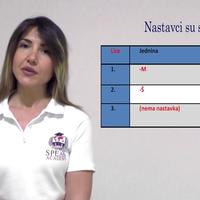Lesson 3.2 Part II Serbian Language - How to Build PRESENT
Lektion 3.2 Teil II Serbische Sprache – Wie man PRESENT aufbaut
Lesson 3.2 Part II Serbian Language - How to Build PRESENT
Leçon 3.2 Partie II Langue serbe - Comment construire le PRÉSENT
Lezione 3.2 Parte II Lingua serba - Come costruire PRESENT
Урок 3.2 Часть II Сербский язык – Как построить настоящее время
Ders 3.2 Kısım II Sırp Dili - PRESENT Nasıl Oluşturulur
PREZENT
Sad je vreme da naučimo kako se gradi prezent.
Jetzt ist es an der Zeit zu lernen, wie man ein Geschenk bastelt.
U srpskom jeziku prezent se gradi od prezentske osnove i nastavaka (prezentska osnova + nastavci).
In the Serbian language, the present tense is built from the present stem and continuations (present stem + continuations).
Prezentsku osnovu dobijamo tako što od prvog lica množine prezenta odbijemo nastavak –mo, recimo ako imamo glagol trčati:
We get the present base by removing the suffix -mo from the first person plural of the present, for example if we have the verb to run:
Mi trčimo
We are running
Mi trčimo
Osnova je trči-.
The basis is run-.
Njoj dodajemo nastavke.
We are adding sequels to it.
Nastavci su sledeći:
The sequels are as follows:
Oni pričaju.
They are talking.
Oni vuku.
They pull.
Oni trče.
Kada se koji od ova tri nastavka upotrebljava, govorićemo u nekoj od narednih lekcija.
We will discuss when any of these three endings are used in one of the following lessons.
Glagol zvati se u prezentu (potvrdni oblik)
The verb to be called in the present tense (affirmative form)
Glagol imati (prezent, potvrdni oblik)
Da bismo dobili odrični oblik glagola, dodaćemo ispred rečcu ne. Rečca ne piše se odvojeno od glagola.
To get the negative form of the verb, we will add no in front of the word. The word is not written separately from the verb.
Ja se ne zovem Marija. Ja se zovem Aleksandra.
Ali, kod glagola imati, rečca ne piše se spojeno sa glagolom.
But, with the verb to have, the word is not written in conjunction with the verb.

